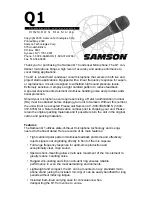
6
GA0383P02 Rev. C
Application
The Generator Condition Monitor for air-cooled machines (GCM-A) is a sensitive real-time
instrument designed to provide early warning indication of overheating (or arcing) in air-
cooled generators before extensive damage can occur. Tests conducted on operating air-
cooled generators have shown that the GCM-A can detect thermal decomposition of small
amounts of insulating materials.
Thermal decomposition of organic materials such as epoxy paint, core lamination enamel or
other insulating materials used in the generator results in the production of a large number
of small particles. The onset of particle production, as the material is heated, occurs at a
temperature characteristic of the material (thermal particulation point) and its surrounding
atmosphere. Below this temperature, no particles are created, yet once the critical
temperature is reached (thermal particulation point – TPP), millions of submicron particles
are generated each second for every square centimeter of surface area.
The GCM-A features:
·
Microprocessor-based electronics
·
Self-diagnostics
·
Output indication
·
Trouble indication
·
Allowance for remote control/display and communication
Principle of Operation
A basic understanding of the GCM-A is necessary to properly utilize the information that the
instrument provides.
Particle detection is by means of a detector utilizing the condensation nuclei principle (cloud
chamber).
In operation, an air sample is delivered to the detector by means of a centrifugal blower
connected to two sets of sampling lines; one line is dedicated to the ambient air and the
second is dedicated to the generator’s cooling circuit. A portion of these air samples is first
diverted into a humidifier and humidified to approximately 100% relative humidity, then
directed to the cloud chamber where it is subjected to a rapid vacuum expansion. The effect
of the vacuum is to cool the air sample and cause water droplets to condense onto particles
that may be present in the air sample.
It is known that particles smaller than the wavelength of visible light occur spontaneously as
material is heated, and in numbers far above those present in a normal ambient
environment. As a result, thermally generated particles cause many droplets to form a cloud
which is then detected by the optical system of the cloud chamber.
Summary of Contents for GCM-X
Page 40: ...39 GA0383P02 Rev C Figure 1 System Overview...
Page 41: ...40 GA0383P02 Rev C Figure 2 GCM A Outline...
Page 42: ...41 GA0383P02 Rev C Figure 3 GCM A Mounting...
Page 44: ...43 GA0383P02 Rev C Figure 5 Closed Circuit H Probe...
Page 45: ...44 GA0383P02 Rev C Figure 6 Closed Circuit U Probe...
Page 46: ...45 GA0383P02 Rev C Figure 7 Open Circuit Sample Heads...
Page 47: ...46 GA0383P02 Rev C Figure 8 Open Circuit Probes...
Page 48: ...47 GA0383P02 Rev C Figure 9 Sampling System 3 8 Typical PVC...
Page 49: ...48 GA0383P02 Rev C Figure 10 Sampling system 1 2 Typical PVC...
Page 50: ...49 GA0383P02 Rev C Figure 11 Sampling System 1 2 Flange Configuration...
Page 53: ...52 GA0383P02 Rev C Figure 14 Sample Probe...
Page 56: ...55 GA0383P02 Rev C Figure 17 Control Panel Detail...








































